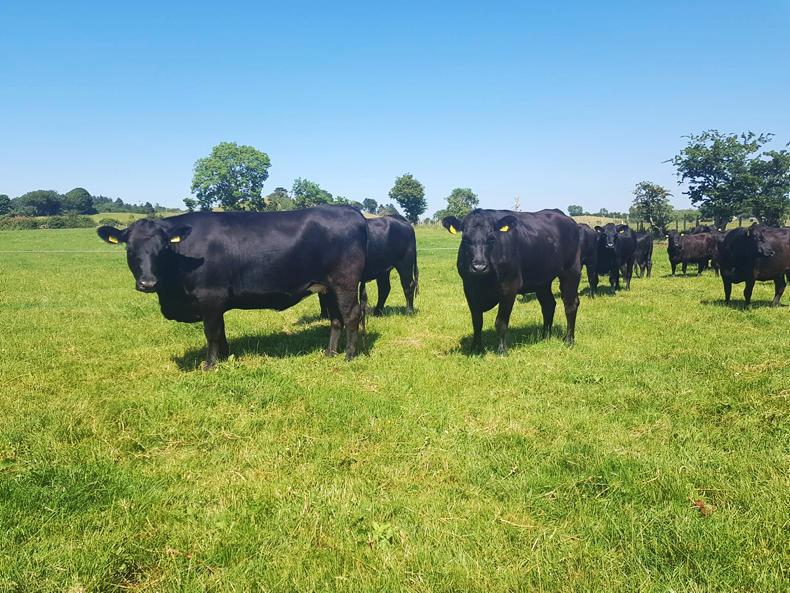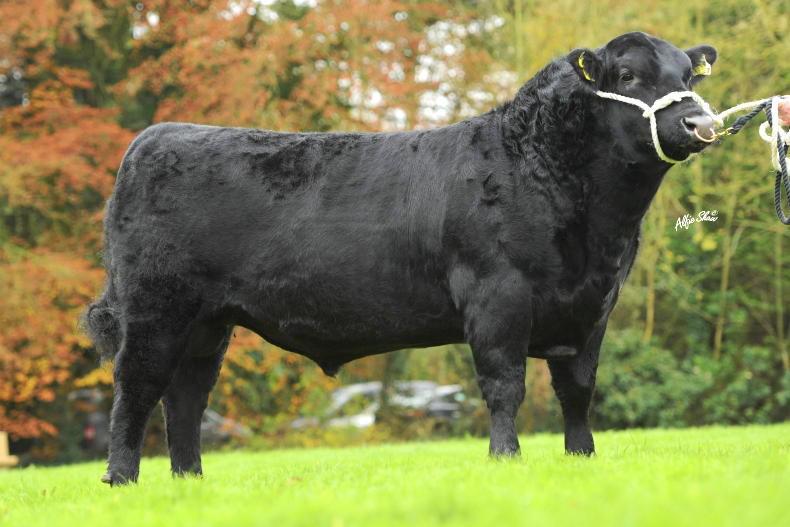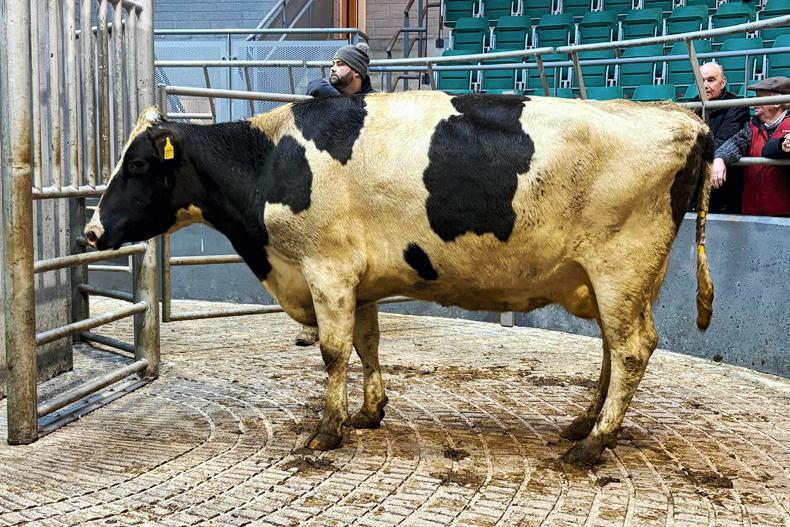Capturing the greatest potential from your grazed grass was the topic of discussion at the Foyle Food Group farm open day. The 160ac farm is owned and run by the Foyle Food Group and is situated just a mile from its factory outside Carrigans.
A good grassland paddock system is in place on the farm to maximise utilisation of grass. Animals are sourced from all over Ireland – 90% of these are certified Irish Angus cattle. Steers and heifers are bought in at between 12 and 18 months and are all slaughtered under 30 months off grass at target carcase weights from 300kg to 380kg.
Foyle Food Group runs a grass-based system on its farm as it sees a growing interest for grass-fed beef among its consumers. Speakers on the day included Gareth Davis from the Gareth Grassland advisory service in Wales, Gary Fisher, Teagasc, and Joe Burke, Bord Bia.

A grassland paddock system is in place on the farm.
Soil and grassland management
Gareth Davis spoke on the importance of good grass management and how it is the cheapest feedstuff that can be fed to our animals. He made the point that “it is quality grass that is a cheap feed and poor quality grass can actually be quite costly”, meaning that grass eaten at the right stage will increase animal performance, whereas grass eaten at the incorrect stage can be wasteful.
He said: “When grazing, it is important to remember what is left behind in the sward will set out the quality of re-growth. The last bit of leaf left behind acts as the plant’s solar panel. It regenerates the energy supply to the plant to be able to push up another leaf. When grass is eaten too tight, we compromise regrowth.
“In any beef system, we need to grow as much high-quality cheap food and best utilise it. With a grazing rotation we are trying to work with the plant not against it.
Gareth told of how essential a paddock system is. “All any rotation is trying to do is give cattle the best quality grass on your farm. Any form of monitoring grass growth is good and it also helps to identify the poorest performing paddocks quicker.”
He then went on to talk about how to best identify grasslands in need of seeds. “A lot of farmers think that land should be reseeded because it has not been reseeded in a number of years when it actually might be the best-performing paddock on the farm. The only way this can be correctly identified is by grass measuring. Paddocks that have never been reseeded might be our best-performing paddocks.”
Following the topic of grassland management, Gareth spoke about the main driver for any good grassland system and that is soil management. “There is only one type of farmer and that is a soil farmer.
The first thing that any farmer should do when assessing the soil in a field is to dig down into the soil to get an understanding of where the problems may lie, eg poor worm activity. Soil testing should then follow this.
‘‘Most poor-performing soil will more than likely have a low pH and these soils will require liming. Liming will set the conditions of the soil but it is important not to overuse lime as high levels of magnesium in lime will tighten up the soil surface and prevent aeration. It is key that we identify the problem before taking action.”

Gerry Smith, Angus Beef Ireland; Gareth Davis, Gareth Grassland advisory service, Wales; Donal Gleesnan, Angus Beef Ireland; Gary Fisher, Teagasc; Gabriel Lynch, Foyle Food Group; Joe Burke, Bord Bia; and Andrew Clarke, Foyle Food Group.
Gary Fisher of Teagasc spoke about early spring grazing. “If we want to target mid-April turn out, fertiliser needs to be spread six weeks earlier than this date. If fertiliser is spread early in the season, good management of grass in May and early June is vital. Grass growth over this period usually exceeds demand.
Gary also talked about topping paddocks during peak growth periods. “A lot of improper topping is carried out on farms. Many farmers like to top for aesthetic reasons but the real reason for topping should always be to maintain quality within the sward. Pasture should ideally be topped to 4cm,” he said.
Gary then spoke about safe handling of pesticide products. He made the point that one foil seal of an MCPA container has enough pesticide to breach regulation standards of 0.1mg/L level along a typical 30km stream.
Markets
Joe Burke of Bord Bia gave a positive outlook on the Irish beef market. Seven Irish factories have now been approved to export meat to China and this number is continually growing. He spoke of the low-input grass system that we can avail of in Ireland, which is very appealing to customers abroad. “When bringing foreign customers on to Irish farms they can’t but be but impressed with the biodiversity that exists on Irish farms.’’
He also told of the growing use of Angus sires as there were over 380,000 calves registered from Angus sires in 2017, with most of these coming from dairy herds.
He made the point that good terminal genetics in these Angus sires will greatly increase the quality of the Angus beef cattle that we are producing.
Joe also emphasised that when finishing cattle they should be fed to their potential as 30% of the meat from the carcase goes towards steak cuts.
Capturing the greatest potential from your grazed grass was the topic of discussion at the Foyle Food Group farm open day. The 160ac farm is owned and run by the Foyle Food Group and is situated just a mile from its factory outside Carrigans.
A good grassland paddock system is in place on the farm to maximise utilisation of grass. Animals are sourced from all over Ireland – 90% of these are certified Irish Angus cattle. Steers and heifers are bought in at between 12 and 18 months and are all slaughtered under 30 months off grass at target carcase weights from 300kg to 380kg.
Foyle Food Group runs a grass-based system on its farm as it sees a growing interest for grass-fed beef among its consumers. Speakers on the day included Gareth Davis from the Gareth Grassland advisory service in Wales, Gary Fisher, Teagasc, and Joe Burke, Bord Bia.

A grassland paddock system is in place on the farm.
Soil and grassland management
Gareth Davis spoke on the importance of good grass management and how it is the cheapest feedstuff that can be fed to our animals. He made the point that “it is quality grass that is a cheap feed and poor quality grass can actually be quite costly”, meaning that grass eaten at the right stage will increase animal performance, whereas grass eaten at the incorrect stage can be wasteful.
He said: “When grazing, it is important to remember what is left behind in the sward will set out the quality of re-growth. The last bit of leaf left behind acts as the plant’s solar panel. It regenerates the energy supply to the plant to be able to push up another leaf. When grass is eaten too tight, we compromise regrowth.
“In any beef system, we need to grow as much high-quality cheap food and best utilise it. With a grazing rotation we are trying to work with the plant not against it.
Gareth told of how essential a paddock system is. “All any rotation is trying to do is give cattle the best quality grass on your farm. Any form of monitoring grass growth is good and it also helps to identify the poorest performing paddocks quicker.”
He then went on to talk about how to best identify grasslands in need of seeds. “A lot of farmers think that land should be reseeded because it has not been reseeded in a number of years when it actually might be the best-performing paddock on the farm. The only way this can be correctly identified is by grass measuring. Paddocks that have never been reseeded might be our best-performing paddocks.”
Following the topic of grassland management, Gareth spoke about the main driver for any good grassland system and that is soil management. “There is only one type of farmer and that is a soil farmer.
The first thing that any farmer should do when assessing the soil in a field is to dig down into the soil to get an understanding of where the problems may lie, eg poor worm activity. Soil testing should then follow this.
‘‘Most poor-performing soil will more than likely have a low pH and these soils will require liming. Liming will set the conditions of the soil but it is important not to overuse lime as high levels of magnesium in lime will tighten up the soil surface and prevent aeration. It is key that we identify the problem before taking action.”

Gerry Smith, Angus Beef Ireland; Gareth Davis, Gareth Grassland advisory service, Wales; Donal Gleesnan, Angus Beef Ireland; Gary Fisher, Teagasc; Gabriel Lynch, Foyle Food Group; Joe Burke, Bord Bia; and Andrew Clarke, Foyle Food Group.
Gary Fisher of Teagasc spoke about early spring grazing. “If we want to target mid-April turn out, fertiliser needs to be spread six weeks earlier than this date. If fertiliser is spread early in the season, good management of grass in May and early June is vital. Grass growth over this period usually exceeds demand.
Gary also talked about topping paddocks during peak growth periods. “A lot of improper topping is carried out on farms. Many farmers like to top for aesthetic reasons but the real reason for topping should always be to maintain quality within the sward. Pasture should ideally be topped to 4cm,” he said.
Gary then spoke about safe handling of pesticide products. He made the point that one foil seal of an MCPA container has enough pesticide to breach regulation standards of 0.1mg/L level along a typical 30km stream.
Markets
Joe Burke of Bord Bia gave a positive outlook on the Irish beef market. Seven Irish factories have now been approved to export meat to China and this number is continually growing. He spoke of the low-input grass system that we can avail of in Ireland, which is very appealing to customers abroad. “When bringing foreign customers on to Irish farms they can’t but be but impressed with the biodiversity that exists on Irish farms.’’
He also told of the growing use of Angus sires as there were over 380,000 calves registered from Angus sires in 2017, with most of these coming from dairy herds.
He made the point that good terminal genetics in these Angus sires will greatly increase the quality of the Angus beef cattle that we are producing.
Joe also emphasised that when finishing cattle they should be fed to their potential as 30% of the meat from the carcase goes towards steak cuts.













SHARING OPTIONS